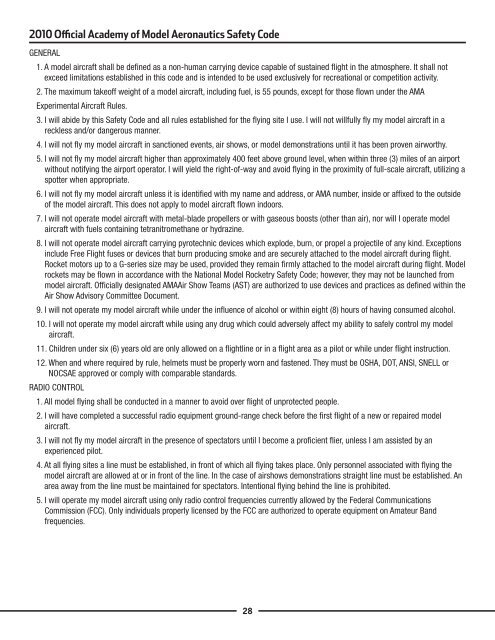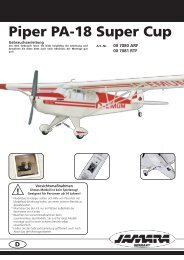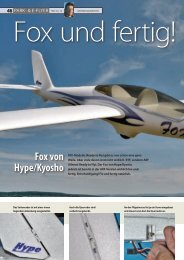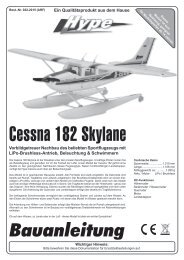Blade CX2 Manual - hapo - trade Modellbau
Blade CX2 Manual - hapo - trade Modellbau
Blade CX2 Manual - hapo - trade Modellbau
Create successful ePaper yourself
Turn your PDF publications into a flip-book with our unique Google optimized e-Paper software.
2010 Official Academy of Model Aeronautics Safety Code<br />
GENERAL<br />
1. A model aircraft shall be defined as a non-human carrying device capable of sustained flight in the atmosphere. It shall not<br />
exceed limitations established in this code and is intended to be used exclusively for recreational or competition activity.<br />
2. The maximum takeoff weight of a model aircraft, including fuel, is 55 pounds, except for those flown under the AMA<br />
Experimental Aircraft Rules.<br />
3. I will abide by this Safety Code and all rules established for the flying site I use. I will not willfully fly my model aircraft in a<br />
reckless and/or dangerous manner.<br />
4. I will not fly my model aircraft in sanctioned events, air shows, or model demonstrations until it has been proven airworthy.<br />
5. I will not fly my model aircraft higher than approximately 400 feet above ground level, when within three (3) miles of an airport<br />
without notifying the airport operator. I will yield the right-of-way and avoid flying in the proximity of full-scale aircraft, utilizing a<br />
spotter when appropriate.<br />
6. I will not fly my model aircraft unless it is identified with my name and address, or AMA number, inside or affixed to the outside<br />
of the model aircraft. This does not apply to model aircraft flown indoors.<br />
7. I will not operate model aircraft with metal-blade propellers or with gaseous boosts (other than air), nor will I operate model<br />
aircraft with fuels containing tetranitromethane or hydrazine.<br />
8. I will not operate model aircraft carrying pyrotechnic devices which explode, burn, or propel a projectile of any kind. Exceptions<br />
include Free Flight fuses or devices that burn producing smoke and are securely attached to the model aircraft during flight.<br />
Rocket motors up to a G-series size may be used, provided they remain firmly attached to the model aircraft during flight. Model<br />
rockets may be flown in accordance with the National Model Rocketry Safety Code; however, they may not be launched from<br />
model aircraft. Officially designated AMAAir Show Teams (AST) are authorized to use devices and practices as defined within the<br />
Air Show Advisory Committee Document.<br />
9. I will not operate my model aircraft while under the influence of alcohol or within eight (8) hours of having consumed alcohol.<br />
10. I will not operate my model aircraft while using any drug which could adversely affect my ability to safely control my model<br />
aircraft.<br />
11. Children under six (6) years old are only allowed on a flightline or in a flight area as a pilot or while under flight instruction.<br />
12. When and where required by rule, helmets must be properly worn and fastened. They must be OSHA, DOT, ANSI, SNELL or<br />
NOCSAE approved or comply with comparable standards.<br />
RADIO CONTROL<br />
1. All model flying shall be conducted in a manner to avoid over flight of unprotected people.<br />
2. I will have completed a successful radio equipment ground-range check before the first flight of a new or repaired model<br />
aircraft.<br />
3. I will not fly my model aircraft in the presence of spectators until I become a proficient flier, unless I am assisted by an<br />
experienced pilot.<br />
4. At all flying sites a line must be established, in front of which all flying takes place. Only personnel associated with flying the<br />
model aircraft are allowed at or in front of the line. In the case of airshows demonstrations straight line must be established. An<br />
area away from the line must be maintained for spectators. Intentional flying behind the line is prohibited.<br />
5. I will operate my model aircraft using only radio control frequencies currently allowed by the Federal Communications<br />
Commission (FCC). Only individuals properly licensed by the FCC are authorized to operate equipment on Amateur Band<br />
frequencies.<br />
28






